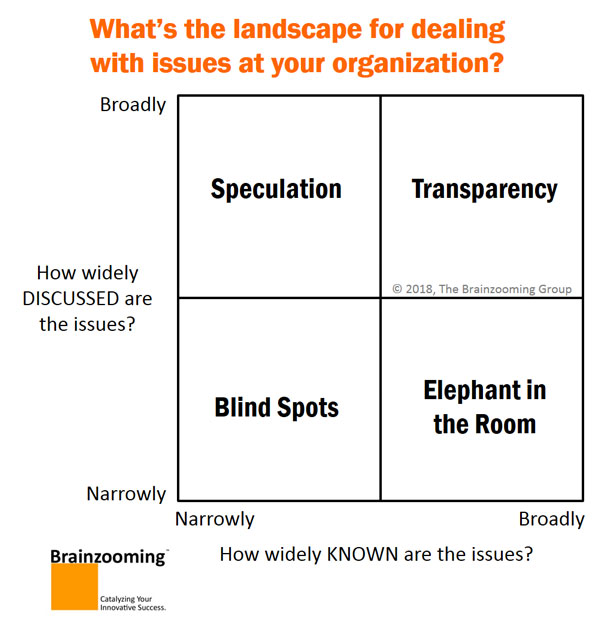This matrix on 4 ways your organization can deal with major issues is DEFINITELY courtesy of the Brainzooming R&D lab.
Going back through notes and strategic planning posters from previous client engagements, I came across a big easel sheet. It was used during a particularly long and particularly challenging strategic planning workshop. The notes all pertained to tackling elephant in the room issues. These are issues inside an organization that everyone knows about (and will discuss in private) but that are NEVER discussed in meetings or any type of formal group setting. For this organization, which was undergoing a significant transition, many years of micro-managing resulted in at least one huge page’s worth of elephant in the room issues.
4 Ways to Address or Avoid Major Strategic Issues
That combination of knowing and discussing major issues led me to wonder: What are all the potential combinations of an organization knowing and discussing major strategic issues? That thought experiment is played out in this matrix.

You can see the elephants in the room in the lower right. Blind spots are in the lower left; these are the issues in the organization that are narrowly known and discussed. Failing to uncover issues the organization (and especially its leadership) doesn’t know, but that are very real, typically poses a significant threat.
Speculation occurs when there is a lot of chatter about issues that some might suspect, but for which most of the organization lacks any solid facts.
The upper right – the best quadrant – is transparency, where there is a reasonable balance between knowledge and discussion about major issues within an organization.
Did I mention that his was from the Brainzooming R&D lab? We haven’t used this matrix about major strategic issues in any formal ways yet. The first use will likely take place with an organization dealing with poor communication and a negative environment. We might use it before or during a strategic planning workshop to better understand where major issues are landing. If you do anything with this matrix ahead of that, we’d love to know what you think.
One Final Note: While this matrix is discussed in the context of an organization, it relates to other situations, particularly couples and families, at least based on being able to readily identify interpersonal behaviors within the matrix. So, maybe try it out at home first? But, probably not as a big poster you put up on the wall! – Mike Brown




